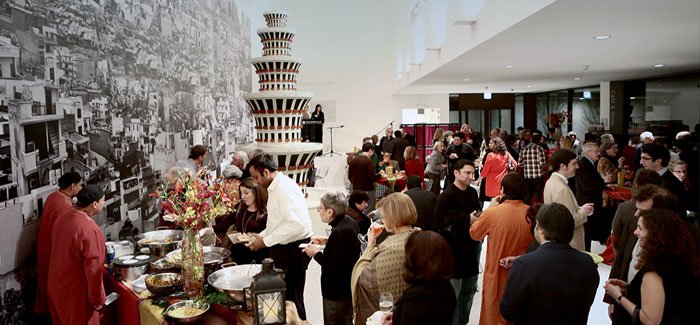
From the opening night of The Sahmat Collective: Art and Activism since 1989 at the Smart Museum. (Photography by Jeremy Lawson)
Showcasing India’s cultural diversity, Sahmat stops in Chicago.
It operates out of a garage, but Sahmat, a Delhi-based arts collective, has never stayed put. For 24 years, the collective has organized exhibitions, performances, and symposia across India. This winter its reach extended to the United States and the Smart Museum: after three years of planning, The Sahmat Collective: Art and Activism since 1989 opened on February 13.
The exhibition showcases pieces from Sahmat’s archive, one so vast that the show’s cocurators put together a 296-page retrospective book. Turning the pages to research a Magazine story on the show, I marveled at the diversity of Sahmat-sponsored work—multicolored illustrations, minimalist installations, postcard tributes to Gandhi, and more. But there was no mistaking the common thread: a drive to resist sectarianism and embrace India’s multicultural history.
Those themes were on display during the Sahmat Collective opening reception, which included a performance by the Indian classical dance RSO Apsara. Five dancers scattered throughout the Smart lobby performed Samhara, which merges the Bharatanatyam, Kathak, and Odissi styles. The performers played off one another, highlighting each style’s singular qualities while celebrating their common heritage.
Above left is a video of two Apsara dancers on the lobby’s right buttress, followed by several images from the exhibition.
[[{"type":"media","view_mode":"media_original","fid":"645","attributes":{"alt":"","class":"media-image","height":"671","typeof":"foaf:Image","width":"460"}}]]
Atul Dodiya, B for Bapu, 2001. Exterior: oil and enamel paint on grilled metal roller shutter; interior: acrylic and varnish on canvas with thread and lock. (Collection: Lekha and Anupam Poddar, Delhi.)
B for Bapu by Atul Dodiya was part of the 2002 exhibit Ways of Resisting. Made of acrylic and varnish and covered by a grilled metal shutter, the work represents awareness of a harsh reality, writes Dodiya in his artist’s statement—“death, decay, corruption, compromise, struggle are not distant metaphors of the fall of man. These are real, right here, lived with. Metallic omnipresence … Gandhi’s absence manifests itself in the different mounds of ruin—the political mess, the hypocrisy, and deceit of the individual in the national playground where we are all sliding down.”
[[{"type":"media","view_mode":"media_original","fid":"644","attributes":{"alt":"","class":"media-image","height":"695","typeof":"foaf:Image","width":"460"}}]]
Zarina Hashmi, River of Tears (detail), 2007. Faux pearls on string. (Courtesy Gallery Espace, New Delhi. Photography by Jeremy Lawson.)
Coming from a secular Muslim family that was divided across the two countries of India and Pakistan, Zarina Hashmi created River of Tears, which expresses the pain of the 1947 partition of India: “It was like a river of tears for millions of people who had to leave their homes and settle in a new place,” she says in the exhibition book.
[[{"type":"media","view_mode":"media_original","fid":"643","attributes":{"alt":"","class":"media-image","height":"809","typeof":"foaf:Image","width":"460"}}]]
Installation view of Photo Booth with Cutout Figure of Husain, 2010. Digital photograph and robe on stand with hand-painted film banner backdrop. (Collection of Sahmat. Photography by Jeremy Lawson.)
On display at the Smart is an M. F. Husain photo booth, created in 2010 by Ram Rahman to mark the 95th birthday of the late Husain. A Muslim artist who had painted images of Hindu goddesses for decades, in the 1990s Husain became a target of Hindu groups who took exception to his bare-breasted depictions. The piece was designed to evoke Husain’s presence while the artist himself was in self-imposed exile. Visitors to the Smart show continue the tradition of posing for photos alongside the cutout.
Video
Part of a dance performed by two Apsara dancers at the opening reception at the Smart Museum of Art.
